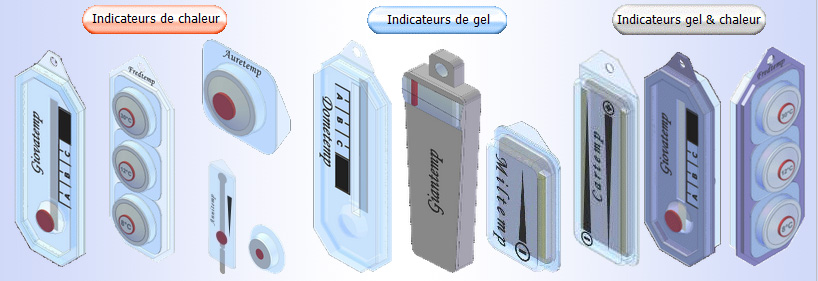Definition of the Cold Chain
We call cold chain or cooling chain all logistics and domestic operations (transport, handling, storage) to maintain one or more product (usually food, pharmaceutical or environmental) at a low temperature, to ensure its continuous safety.
We need to emphasize on the importance of the continuity of the stages; no link should break and destroy the bulk of the overall effort. It should result ultimately to a product preserved from overheating, thus breaking the cold chain.
The Sanitary regulations, which sets the optimal temperatures for food conservation, relies on traditional science. It takes into consideration the evolution of consumption habits, agrifood technological development and their inherent risks. Its objective is to ensure the consumers safety.
Choice of Regulatory Conservation Temperatures
The choice of regulatory temperatures, of each commodity conservation, is based on precise and specific criteria for each family. These criteria are of several types.
Nature of commodity
Each type of food has a limiting factor in the choice of the storage temperature. Often it is a microorganism which may be naturally present, i.e several non-pathogenic species of Salmonella are hosts of the poultry digestive tube.
In this case, the cold storage temperature, recommended for the commodity, is based on Microbiological knowledge of the critical living environment of the organism, keeping in mind that the cold allows an inhibition of growth, in other words, a stop or slow down of the multiplying and this phenomenon is reversible as soon as the food is exposed to a higher temperature, which is the optimal living environment for the bacteria.
The heat treatment by very low temperature (freezing or deep freezing) for a more or less long period of time, can also apply for the remediation of trichinous or stingy meat (tapeworm). On the contrary shell eggs, if they should be stored at normal room temperature (20° C), away from sunlight, should not be subjected to repeated thermal shocks, which reduces the natural protection of the shell. On the other hand for the consumer, refrigeration of eggs optimizes their conservation.
Fresh fish undergoes enzymatic phenomena very weakening, because its conservation is requested at the temperature of melting ice, eg between 0° C and 2° C.
Minced meat and fish fillets also demand a temperature in this range, because the thread or cutting up, are destabilizing transformations for the flesh that makes it more vulnerable.
Marketed live shells, should not be stored at the same temperatures as fish, which they are commonly associated, for obvious commercial reasons, however it is not recommended.
Condition of obtaining the commodity
The non bleeding hunted prey, is a more fragile commodity that meat obtained in slaughterhouses. Outside the Tenderising, which must remain an operation performed by the consumer for his own consumption, storage temperatures align with those of the corresponding domestic species (butchers meat for deer and wild boar, poultry for wildfowl).
Raw milk, pasteurized milk, gastronomic tradition of poultry, were shorten their duration of conservation in temperature, equal or close to corresponding products that have been treated normally.
The cheeses, especially those benefiting from AOC (Controlled Label of origin), have a particular specification which takes into account of course food security and refining constraints. The conservation temperature is then recommended on the label.
Cold & Food Quality (cold chain)
Specifications
The specifications of a manufacturer or packager or even of a distributor, can go further than regulation. For commercial presentation reasons, or in order to ensure the maintenance of certain organoleptic qualities, a customer, or a supplier may request that the product should be stored at temperatures inferior to the prescribed ones (i.e ice cream). However, it is appropriate that these specifications remain on the appropriate level in order to avoid an inapplicable escalation.
In addition, when the product durability is fixed under the manufacturer's or packager's liability, it is important that all other intermediaries ensure the perfect control of the product's temperature during the steps towards the placing on the market.
Frozen Food
The term "frozen" is related to the technological process that combines three major criteria:
- Very rapid temperature reduction that allows the backup of the cellular structures and thus a better quality and better organoleptic preservation,
- Raw materials of choice
- Conservation at -18° C inhibit the growth of most micro-organisms, including fungus.
The regulation must be a compromise between the probability of the development of germs and enzymatic phenomena et la conservation of organoleptic qualities expected by the consumer. However it is important to know where everyone must exercise its responsibility in order to ensure the maximum food safety.
Therefore the temperature imposed by regulators or by a packager, for the storage of a commodity, allows on the basis of scientific evidence and/or self-checks, to assume its sustainability. Gold sustainability is a fixed capital, each breaking of the cold chain (temperature shock, steady temperature rise of a few degrees) just begin. This capital must be saved by all the links in the chain, including the final consumer, who must consider the cold as a quality factor and absolute security.
Finally, the control of the Hygrometry, the choice of the location of the temperature sensors, the placement of goods in display cabinets, the frequency of the de-icing operations, the speed of loading and unloading, as well as the optimization of logistics operations in general, are all necessary criteria that must be taken into account during evaluation and control of the cold chain.
The range of XTEMP facilitates the management of your cold chain

